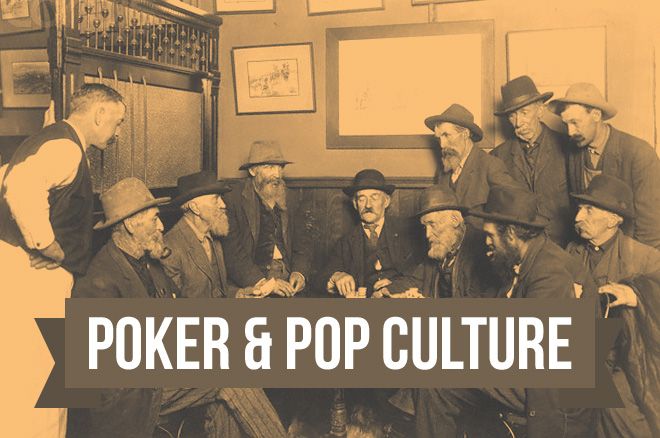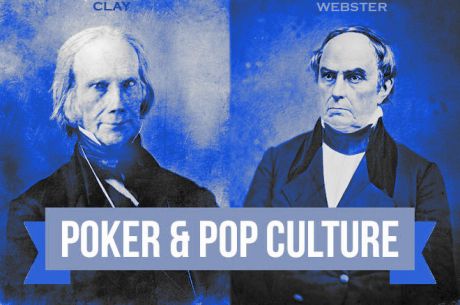Poker & Pop Culture: Following Draw, "Stud-Horse Poker" Gallops In

"Part of the genius of poker is its endless capacity for development," explains Al Alvarez in Poker: Bets, Bluffs and Bad Beats, just before going on to list a few of the "literally hundreds of variations" of card games that can be said fall into the poker category.
"Essentially, all these games, even the craziest, are variations of two basic themes: closed or draw poker, in which all the cards are dealt facedown, and stud, in which four of the player's five or seven cards are dealt faceup."
It's a crucial distinction �� perhaps the most important one to make among all poker variants, as far as the game's historical evolution is concerned.
"Closed" poker games came first, starting with "Old Poker" (in which there were no discards or draws), then draw poker and its many descendants. Then came the idea to show some of a hand �� before the showdown �� and from these first stud games many more "open" poker variants followed (including, much later, Texas hold'em).
As we've discussed, the earliest references to poker describe games from the 1820s and 1830s, with draw poker being part of the story from very early in the game. Meanwhile it isn't until the 1860s that talk of stud �� like draw, a five-card game (in its first incarnation) �� begins to surface.
The chronological gap between the first draw poker strategy books (in the 1870s) and the earliest ones concentrating on stud (in the 1930s) is similarly wide. Cultural portrayals of stud tend to lag behind as well, with draw being the game much more often portrayed in stories, paintings, and films, right up until the latter half of the 20th century.
As we move toward some of the more interesting stories and representations of poker in the 19th century, let's go ahead and put stud on the table now, as the game will be called here and there in the poker and pop culture mix.
"The Game Began as Draw"
The 1864 edition of the American Hoyle features the first recorded reference to stud �� just a brief postscript to the longer discussion of draw by provided by William Brisbane Dick (a.k.a. "Trumps").
"In all essential particulars," explains "Trumps," stud "is like the other Poker games, and is subject to the same laws, and mode of betting, passing, etc." However, there's one "essential particular" that makes stud entirely unique: "Five cards are dealt, one at a time �� the first dealt as usual, face down, all the others face up."
Not explained here is how the game would soon adopt the procedure of including betting rounds after those first two dealt cards (one down, one up), then also after each of the next three cards are dealt to offer four chances to bet rather than the two rounds in draw. Also, there generally weren't limits on the betting (other than table stakes), and so with twice the number of betting rounds than in five-card draw, the pots in five-card stud could grow especially large.
The exact same paragraph without alteration or addition would continue to appear in subsequent editions of Hoyle well into the 20th century, indirectly suggesting a relative lack of notice and/or popularity when compared to draw.
Later stud scholars would fill in details of the game's invention, including a colorful account from George Henry Fisher in his popular Stud Poker Blue Book (1931) that imagines how the idea of an "open" game like stud might have been derived from the "closed" draw game that preceded it.
Fisher tells of a game occurring in an Ohio saloon just after the Civil War.
"The game began as Draw," writes Fisher, going on to describe a hand in which a player is dealt three kings, then bets and gets called before the draw. More betting and raising ensues after the draw, but the hand gets interrupted when the player with trip kings has to run away from the table to calm down an agitated stallion hitched outside.
Upon his return, "he realized that during his absence the other players had probably seen his three kings." He then proposes a rule change, suggesting that each of the other players turn up three of their cards, discarding the other two, then allowing everyone to draw two new cards to be kept face down before they have one more round of betting.
Since he'd already put in the last of his cash before dashing off, the player offers to bet the stallion he's just been busy taming. "I'll gamble this here thoroughbred stud-horse on my chances," he says, obviously emboldened by his three kings.
It's a fun story, introducing both the idea of exposing some (not all) of one's hand prior to the showdown as well as the innovation to add another betting round. Not only that, the conclusion even seems to provide an answer to the question of how this new version of the game came to be called "stud."
Poker players reading this are likely suspicious, though, trained as they are to spot when details of a story �� like the ones supporting a implausible bluff �� don't quite add up.
It's that punch line about betting the stallion that signals the story is at best embellished, and most likely invented out of whole cloth. After all, if the 1864 American Hoyle had already described a game called "stud poker," the game �� and the name �� couldn't have been invented after the Civil War concluded a year later.
Attempts to Rein in "Evil" Stud-Horse
Even if Fisher's literal dramatization of draw having evolved into stud during the course of a single hand isn't to be believed, his dating of the game's origin to just after the Civil War is correct. Not long after that a few stud stories do begin to appear, such as one much-told one involving the gambling gunfighter Doc Holliday winning $40,000 at stud once in the early 1880s.
More concrete historical evidence is provided by lawmakers' efforts to slow down the growth of stud. For example, "An Act to restrict gaming, and to repeal all other Acts in relation thereto" was approved by the Nevada legislature on March 8, 1879 that specifically prohibited "stud-horse poker" (and several other gambling games) from being spread unless the proprietor obtained a license to do so from the county sheriff, paying a hefty $100 for the first month and $75 each month thereafter.
The reference is often said to be the first calling the game "stud-horse," a name that even more explicitly connects the game with the cowboys who played it. As James McManus has pointed out in Cowboys Full, the hyphenated name additionally "reflects poker's westward push with a decidedly masculine ring," evoking as it does the farm owner's male horse kept for breeding.
Those in Nevada who couldn't find a game could for a time head west to California, where stud had become so popular San Francisco's Chief of Police would complain to the city's board of supervisors about repeatedly having to break up games. The Chief's thoughts on the matter were preserved in an early July 1884 article republished in The New York Times under the heading "The Evils of Stud-Horse Poker."
"I desire to call your attention to the prevalence of a game known as stud-horse poker," writes the Chief, "which is extensively played for money in saloons and other public places in this city. It is not less injurious and demoralizing than faro and other games that are prohibited by law." He goes on to describe "the magnitude of the evil which has resulted" from the game, which in his view "fosters idleness, and tempts many young men of weak resolution to steal from their employers."
The argument was convincing, as the following year an amendment was made to a previous anti-gambling statute, adding "stud-horse poker" to the list of prohibited games �� and creating some headaches for those wanting to play stud games in California lasting well into the next century.
Draw Dominates, Stud Scarce
As noted, books on draw strategy start to arrive not long after the Civil War, but the first stud strategy titles don't really begin appearing for another half-century, with Fisher's 1931 book an important early entry in that strategy subcategory. That the book appeared as part of the popular "Little Blue Book" series of pocket-sized titles produced by the Haldeman-Julius Publishing Company attests to the mainstream appeal of stud by then.
Even if the San Francisco Chief of Police was encountering evil stud games all over his fair city back in 1884, the great majority of late 19th- and early 20th-century stories about poker present draw as the dominant game.
Mark Twain's famous poker story in Life on the Mississippi (1883), "The Professor's Yarn," describes players cheating at draw. David A Curtis similarly sticks with draw in his collections of poker tales Queer Luck (1899) and Stand Pat (1906). Eugene Edwards includes but one passing reference to stud in Jack Pots: Stories of the Great American Game (1900). And while O. Henry features a character offering "to deal a hand or two of stud poker" in a 1908 story, "Babes in the Jungle," the invitation isn't accepted.
Cultural depictions of stud are also relatively scarce until well into the 1900s. Draw poker is much more likely to be the game featured, such as in Frederic Remington's painting "A Misdeal" (1897) where the remnants of a draw hand �� and a subsequent shootout �� fill the scene. Cassius M. Coolidge's series of paintings showing dogs playing poker from 1903 similarly highlights draw as the favored game of the card-playing canines.
Most early films featuring poker also show draw, not stud, a trend that continues right up through the 1960s when The Cincinnati Kid and Cool Hand Luke at last both famously play hands of five-card stud.
Storytelling and Stud
Five-card stud isn't a complicated game, although the seven-card variant that would be later introduced can take new players a little time to learn. Draw tends to work better on the silver screen, although with some care in the script and direction, a stud hand can produce as much or more drama.
That said, stud perhaps requires a bit more exposition first. Anyone recall the valiant efforts of ESPN back in 2004 to show seven-card stud, seven-card stud hi-low, and razz final tables from that year's World Series of Poker? For storytellers, describing a game with just a couple of betting rounds and no cards shown until the end arguably presents a simpler option.
In any case, for those curious about poker's history and cultural representations of the game, the "closed" versus "open" distinction among poker variants �� as represented by draw and stud �� seems almost symbolic, given the way certain details of poker's story remain hidden while others are in plain sight.
From the forthcoming "Poker & Pop Culture: Telling the Story of America��s Favorite Card Game." Martin Harris teaches a course in "Poker in American Film and Culture" in the American Studies program at UNC-Charlotte.
Want to stay atop all the latest in the poker world? If so, make sure to get PokerNews updates on your social media outlets. Follow us on Twitter and find us on both Facebook and Google+!









